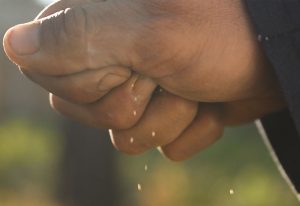
“On this piece of land”
In his article “On this piece of land” Salvador Gutierrez Zamora talks about a space where life and diversity make way for the creation of what will eventually become an edible forest.
In the great plains, hundreds of hectares covered by transgenic corn make the landscape a yellowish canvas, an ocean of grain that disappears into the horizon, and like the sea, it has a base of sandy soil, probably just as more poisoned than the waters and air that cross the great cities. In these monocultures, life and diversity are part of a myth of what these forested lands once were. Curious are the signs that can be found on the roads that cross the cornfields, warning the thief or the hungry not to harvest “due to possible poisoning.”
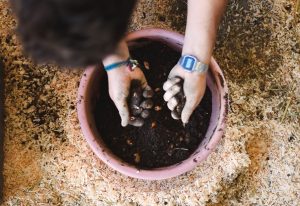
Process of wrapping seeds in soil
Photography: Salvador Gutiérrez
It should not be difficult to find a similar scenario in any country, since the establishment of monocultures dates back to remote times. Mechanization, agrochemistry and genetic alteration of seeds only innovated destructive agricultural practices that have metastasized across the planet through advertising, science, curricula, diets, among other control mechanisms focused on currencies and not on the food security of the people.
“The restoration of the earth and the human heart are a single and inseparable process.” Masanobu Fukuoka.
Seed sowing technique
Photography: Salvador Gutiérrez
Run around by necessity and distracted by screens, the human species remembers little that there is a nature from which it feeds and with which it must make peace if it wants to resume physical, emotional and spiritual well-being. The Japanese sage, Masanobu Fukuoka, already said it in his book The revolution of a blade of straw: “The restoration of the earth and the human heart are a single and inseparable process”. In the same text, he proposed natural agriculture as the means to achieve both objectives, an agriculture contrary to industrial agriculture, based on respect and monitoring of the amazing natural processes.
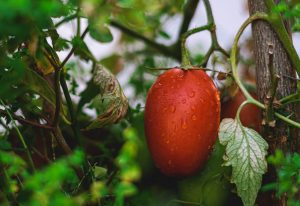
Tomato plants
Photography: Salvador Gutiérrez
We mixed soil, manure, and seeds of various sizes and shapes, and made seed balls, or as Fukuoka called them “Nendo Dango”. Before throwing them onto the ground previously covered with compost, straw, shells and so on, they told us: “Let’s play God.” Days later the rains came and the sprouts of corn, beans, epazote, tomato, quelites, among other varieties, began to be visible.
The soil, an organism with memory, brought life back to the present with force, doing what only this incomprehensible ecosystem under our feet knows how to do perfectly. Our role in the process was so simple that it could not be taken seriously by the ego, however, covering with straw and seeds was the beginning of a new landscape, a home for insects, birds, reptiles and other beings that came to this place full of healthy food, without chemicals or war. This agriculture focused on the sovereignty of the communities, shows us that with land, water, straw and seeds it is enough to heal the human being and the surrounding environment.
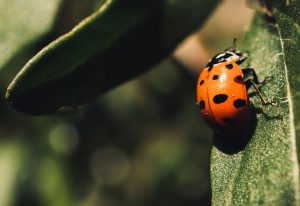
Insects back in the garden
Photography: Salvador Gutiérrez
Now, in this piece of land of a few square meters, the cornfield, vegetables, shrubs and trees make the landscape a set of greenish linens. A cenote of vegetables and fruits whose soil full of microorganisms, bacteria, minerals and fungi purify the water and air that crosses through this space. Life and diversity make way for the creation of what will eventually be an edible forest. A small sign at the entrance to this orchard invites the curious to harvest without fear of being considered hungry or a thief.
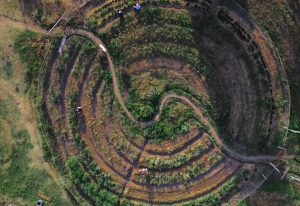
Aerial view after two years of soil regeneration
Photography: Andrés Torres


